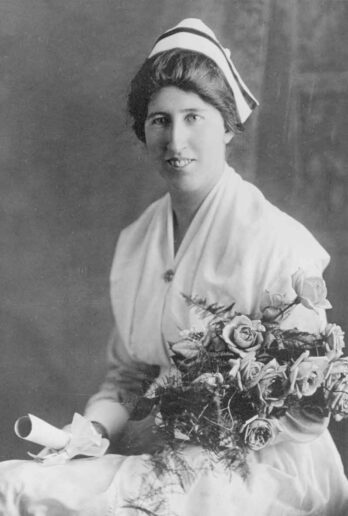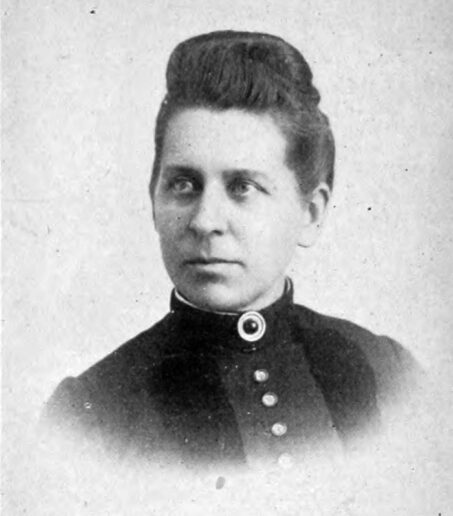March is Women’s History Month and Greater Flint has produced its share of heroines throughout the years. From the arts, healthcare, education, civil rights and more, local women have been (and continue to be) a major force in the molding and shaping of Genesee County and our nation. There is no doubt that without the influence and courage of women working for a better world from the pioneer days to our current time, we would never have achieved all the best of our cities or realized our true potential.
MCM is proud to recognize ten of Greater Flint’s historical female standouts.
 Olive Beasley
Olive Beasley
Greater Flint has made a positive impact on the nation in multiple ways – especially in the area of civil rights, where Olive Beasley played a significant role. Born in 1903 in Chicago, IL Beasley came to Michigan in 1947. She served as the Executive Director of the Michigan Committee on Civil Rights and in 1959, became a member of the Fair Employment Practices Commission. She then moved to Flint and served as executive director of the city’s office of the Michigan Civil Rights Commission. In Flint, her impact was profound and immediate with many calling her the “matriarch of the Civil Rights movement in Flint.”
Beasley’s biggest impact was perhaps felt during the tumultuous 1960s when she led the charge to obtain equal housing opportunities for African Americans. When the City Commission, under protest by Flint’s first African American mayor Floyd McCree, refused to grant an open housing ordinance, Beasley organized a ten-day sleep-in protest on the lawn of Flint City Hall that sent shockwaves throughout the state. Soon, the protest gained nearly 5,000 participants who included Governor George Romney and state Attorney General, Frank Kelley. In response, the City Commission capitulated and in 1968, Flint became the first U.S. city to pass a fair housing ordinance. Throughout her professional life, Beasley continued to work for civil and workers rights with dedication and peace.
 Mildred Doran
Mildred Doran
Mildred Doran was born in 1905 in Renfrew, Ontario, Canada to farmer William Doran and mother, Minnie. Her family soon moved to Flint where she was raised. When she was 16, Doran’s mother passed away and the teen began to raise her three younger siblings by taking a job as a telephone operator during classes at Flint High School and continued to do so after graduating in 1924. With the help of William Malloska, owner of the Lincoln Petroleum Company, Doran attended teacher’s training at Michigan State Normal School and began working as a teacher in Caro. While at college, Doran became very interested in aviation and convinced Malloska to enter a plane into the prestigious Dole Air Race in 1927. She was the only woman to enter the race and became a media sensation.
At the time, many believed a woman to be too fragile for a long-distance flight to which Doran replied, “A woman should fly just as easily as a man … Women certainly have the courage and tenacity required for long flights.” Before she left with the flight crew, many tried to convince her to stay behind because the plane began to exhibit engine trouble, but Doran would have none of it. The plane took off and the race began. As other planes arrived in Hawaii without Miss Doran, many began to fear the worst. It was confirmed when, after days of waiting, the plane never arrived and was never found. After her death, a lake in Ontario, Canada, was named in her honor and the Doran Tower was erected at Lincoln Airfield in Flint (since demolished).
 Sarah Edmonds
Sarah Edmonds
In 1841, Edmonds was born in New Brunswick, Canada to a farmer who treated her poorly because she was not born a male. To escape her father and an arranged marriage, she left her family in 1857 and settled in Hartford, CT where she disguised herself as a man and took the name Franklin Thompson to work as a bible salesman. Her travels brought her to Flint where she boarded in the home of Captain William R. Morse. When war broke out, she enlisted as Franklin Thompson and marched with the 2nd Michigan Infantry, also known as the “Flint Union Grays.” Edmonds first worked as a battlefield medic but soon became a courier and spy behind Confederate lines for Union General George McClellan. During one of her missions, Edmonds was injured and could not gain treatment for fear of being discovered. Edmonds deserted the Union Army and traveled to Texas where she worked as a nurse with the United States Christian Commission.
In 1884, Edmonds was cleared of desertion charges and awarded full pension. Edmonds died in La Porte, TX in 1898.
Lois E. (VanZandt) Holt
Lois E. Holt was the first African-American woman to be hired by the Flint school system in any capacity and her dedication and desire to improve educational opportunities for Flint youth remain unsurpassed. Born in 1916 in Black Oak, AR she was the second of four children. The family moved to Flint where Holt attended Flint Community Schools and graduated from Flint Central. She then attended Wilberforce University in Ohio and after graduation, returned to Flint where she was hired by the school district as a teacher in 1942. She went on to receive a master’s degree in social work from the University of Michigan and her doctorate from Michigan State University. In 1952, Holt became active in the Civil Rights movement after marrying Edgar Holt, President of the Flint chapter of the NAACP. The couple began to support and conduct business with the country of Nigeria and to help African college students with immigration problems and employment in Flint. After her husband’s death, Holt founded the Edgar B. and Lois VanZandt Holt Endowed Scholarship at UM-Flint. Since establishment, over 150 students have been beneficiaries. She passed away in 2017.
 Genora Johnson
Genora Johnson
Perhaps no woman embodied the spirit of Flint more than Genora Johnson. Born in Kalamazoo in 1913, she was raised and lived in Flint during her childhood and young adult years and here she made perhaps one of the biggest impacts for the working man and middle class in United States history. During the Sit-down Strike of 1937, it was her actions and those of her contemporaries that played a major role in union victory over General Motors.
Johnson was the founder and organizer of the Women’s Auxiliary and the more militant Women’s Emergency Brigade. It was the Emergency Brigade that blocked local police and industry goons from gaining entry to the plants holding the striking workers, and it was the auxiliary that provided the men with much needed food and encouragement. After the union victory, Johnson moved to Detroit to continue working for the UAW. There, she was assaulted and savagely beaten by industry goons but that never stopped her pursuits for justice. She worked for six decades on behalf of civil rights, workers’ rights and women’s equality. Johnson passed away in 1995.
 Nancy Kovack
Nancy Kovack
Born in Flint in 1935, Nancy Kovack excelled at a very young age. She graduated from Dye School and enrolled at the University of Michigan when she was only 15. She graduated four years later at the age of 19, and the next year was named Miss Flint. During her childhood, she took part in numerous beauty contests winning eight by the time she was 20.
Television and Hollywood came calling soon after and she was cast in her first part in the show “The Verdict is Yours” in 1958. She was a television regular until 1976 with roles in “Voyage to the Bottom of the Sea”, “I Dream of Jeannie”, “Batman”, “Perry Mason”, “The Man from U.N.C.L.E.”, “Star Trek” and many others. Her most noted role was that of Medea in the movie “Jason and the Argonauts” in 1963. In her career, she worked with the likes of Alfred Hitchcock, Adam West, Elvis Presley, Jackie Gleason, Vincent Price and Gregory Peck, to name a few. In 1969, she was nominated for an Emmy Award for Outstanding Single Performance for her role on “Mannix.” She married Indian conductor Zubin Mehta in 1969 and they now reside in Munich, Germany.
 Sophie Kurys
Sophie Kurys
When the men went off to war, opportunities finally opened for women to excel in a variety of pursuits and Sophie Kurys took full advantage. Born in Flint in 1925 and gifted with unnatural athletic ability, she was a star from the very start.
At the age of 14, she scored a record-setting 4,693 points out of 5,000 in the Mott Pentathlon and was the MVP of the Michigan State Basketball Tournament in Lansing. When the All-American Girls Professional Baseball League was started in 1943, Kurys joined and dominated the league. She played with the Racine Belles for eight years during which she became the most prolific base stealer in women’s baseball history, and owned the national record for both sexes until Rickey Henderson beat it in 1994. Kurys still holds the national record for stolen bases in a single season with 201, 71 more than the MLB record set by Henderson in 1982. During her career, the “Flint Flash” stole a total of 1,114 bases and averaged 150 per season. She often led the league in walks and runs and stole five bases in the 16-inning, title-winning game six against the Rockford Peaches. She retired from the sport in 1952 and passed away in Scottsdale, AZ in 2013.
Kurys is a member of the National Women’s Baseball Hall of Fame.
 Margaret McLaren
Margaret McLaren
One of the most notable names in Flint’s history, McLaren made a monumental impact on healthcare in Greater Flint. Born in 1888 in Kent, Ontario, Canada, she grew up working on her family farm. At the age of 28, she moved to Detroit where she studied nursing. She came to Flint in 1922 and took on the role of surgical supervisor at Hurley Hospital. Two years later, McLaren became the general superintendent of the non-profit Women’s Hospital on Lapeer Street. She worked tirelessly for the hospital and after four years, the Women’s Hospital Association gained full approval by the American Medical Association.
McLaren then led planning and fundraising efforts for a new hospital which opened in 1951. Located on Ballenger Highway, the facility was named McLaren General Hospital in her honor. It became the first hospital in the nation named after a nurse and one of the very few named after a woman. After 28 years as head of the hospital, McLaren retired and continued to stay active in the community. She passed away in 1979. McLaren General Hospital remains one of the premier hospitals in Flint and the State of Michigan today.
 Cornelia Chillson Moots
Cornelia Chillson Moots
(aka “Mother Moots”)
Cornelia Chillson Moots was born in Flushing in 1843 to the fierce temperance advocate and slavery abolitionist, Calvin Chillson. Her mother cared for local homeless children and lived a life of charitable pursuits. Her home was a stop on the Underground Railroad and she grew up with a staunch belief in civil rights and equality. While growing up, Moots was known for her fiery nature which may have been inherited from her grandmother who, in the absence of a local preacher, took on the role, giving enthusiastic sermons in school houses and cabins of the day.
At age 15, Moots began teaching and continued to do so until entering Albion College in 1865. There, she earned a reputation as a staunch supporter for equal suffrage. Her time at college was cut short when, in her junior year, the college president criticized her wardrobe and attempted to dictate her style of dress during an assembly. Moots, after speaking her mind, stormed out, never to return. She returned to teaching and soon had a job in Bay City. While there, she became active in the Woman’s Christian Temperance Movement serving three terms as state evangelist, and in the early suffrage movement pushing for equality between the sexes. Later, she acted as a pioneer missionary to the Philippines where she cared for the sick and wounded at hospitals in and around Manila. “Mother Moots” died in 1929.
 Violet Wierzbicki
Violet Wierzbicki
Born in Flint in 1917, Violet Wierzbicki was cut from a different mold. While Flint women were in factories forging the weapons of WW2, Wierzbicki, at the age of 25, took a more direct approach to the war effort. She joined the Women AirForce Service Pilots (WASP) program to fill the void of training flyers caused by eligible men being overseas. The training for WASP was nearly identical to the men in everything but combat. Almost 25,000 women applied and only 1,830 were selected for training. Of those, only 1,074 completed the course. After training, Wierzbicki was assigned to Romulus Army Air Base (MI) and Camp Davis Army AirField (NC). Her job was to ferry planes to and from air bases around the country, tow gunnery targets and serve as a flight instructor. The project was disbanded in late 1944.
Upon her return to Flint, Wierzbicki attempted to gain employment as a pilot but was turned away by the male dominated field. She worked as a secretary for General Motors in Flint before transferring to San Francisco in 1953 where she lived the rest of her life. Women in the WASP program flew over 70 different aircraft during their short time at the helm and 37 women lost their lives in service. In 1977, all WASP flyers were awarded veteran status. In 2009, at the age of 92, Wierzbicki and 300 WASP survivors received the Congressional Gold Medal for their work.
Photos From Sloan*Longway & Wikicommons








